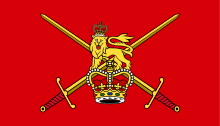Guards Division
The Guards Division is an administrative unit of the British Army responsible for the administration of the regiments of Foot Guards and the London Regiment. The Guards Division is responsible for providing two battalions for public duties to London District (plus three incremental companies); although the guards are most associated with ceremony, they are nevertheless operational infantry battalions, and as such perform all the various roles of infantry.
 |
| Arms of the British Army |
|---|
| Combat Arms |
|
|
| Combat Support Arms |
|
| Combat Services |
|
|
History
The Guards Division was established by redesignation of the Brigade of Guards in 1968. The depot was established at Wellington Barracks in London.[1]
Before the Options for Change defence review in 1992, there were eight battalions:
- 1st and 2nd Battalions, Grenadier Guards
- 1st and 2nd Battalions, Coldstream Guards
- 1st and 2nd Battalions, Scots Guards
- 1st Battalion, Irish Guards
- 1st Battalion, Welsh Guards
The cuts made to the infantry under Options for Change included three battalions of Guards. However, rather than disbanding them, the 2nd Battalions of each of the first three regiments were placed in "suspended animation" - although they would not be active, they would still be listed on the Army Roll, and could be reactivated should they be needed. In order to maintain the traditions of each battalion, and to keep custody of the colours, three companies were kept active, one to represent each battalion:
- No 2 Company, 2nd Bn Grenadier Guards (renamed Nijmegen Company)
- No 7 Company, 2nd Bn Coldstream Guards
- F Company, 2nd Bn Scots Guards
These three units were based permanently at Chelsea Barracks in London on public duties until Chelsea Barracks was sold off by the army. They represent the suspended battalions at significant events, such as Trooping the Colour, and receive the battalion's new colours whenever they are presented. As such, each company is an independent unit of their regiment, separate from the operational battalions.
Current units
Currently units comprise:[2][3]
- Regular Army Units
- 1st Battalion, Grenadier Guards (Public Duties) at Aldershot
- Nijmegen Company, Grenadier Guards
- 1st Battalion, Coldstream Guards (Light Infantry) at Windsor
- No 7 Company, Coldstream Guards
- 1st Battalion, Scots Guards (Strike Mechanized Infantry) moving to Catterick
- F Company, Scots Guards
- 1st Battalion, Irish Guards (Light Infantry) at Aldershot
- 1st Battalion, Welsh Guards (Public Duties) moving to Windsor
- Army Reserve Units
Past units
Past units include:[4]
- 2nd Battalion, Grenadier Guards (1656–1994)
- 2nd Battalion, Coldstream Guards (1711–1993)
- 2nd Battalion, Scots Guards (1689–1993)
Note: The three 2nd battalions have technically not been disbanded; instead they are in "suspended animation" and, in theory, can be re-raised if needed. The colours and traditions of each battalion are kept and maintained by the incremental companies.
Telling the regiments apart
.jpg)
The five regiments of foot guards are most often seen in full dress uniform, comprising navy trousers, scarlet tunic and bearskin cap. From a distance they appear identical, but there are ways to distinguish between the regiments:
- The colour of the plume, and which side of the bearskin it is worn on
- The spacing of the tunic buttons
- The badge worn on the collar
- The badge worn on the shoulder
| Regiment | Plume | Plume colour | Button spacing | Collar badge | Shoulder badge |
|---|---|---|---|---|---|
| Grenadier Guards | Left | White | Singly | Grenade | Royal Cypher |
| Coldstream Guards | Right | Red | Pairs | Garter Star | Rose |
| Scots Guards | N/A | N/A | Threes | Thistle | Thistle Star |
| Irish Guards | Right | Blue | Fours | Shamrock | St Patrick Star |
| Welsh Guards | Left | White-Green-White | Fives | Leek | Leek |
See also
- Household Division
- Guards Division for the tactical formation active in World War I (and briefly at the end of World War II)
- Guards Armoured Division for the tactical formation active in World War II
List of Bands:
References
- "Wellington Barracks Review". Retrieved 18 April 2014.
- Heyman, p.88
- "Archived copy" (PDF). Archived from the original (PDF) on 10 June 2014. Retrieved 1 December 2015.CS1 maint: archived copy as title (link)
- Whitaker's Almanack 1969
Sources
- Heyman, Charles (2012). The British Army: A Pocket Guide, 2012-2013. Pen & Sword.
External links
- Brigade of Guards at regiments.org by T.F.Mills at the Wayback Machine (archived 15 July 2007)